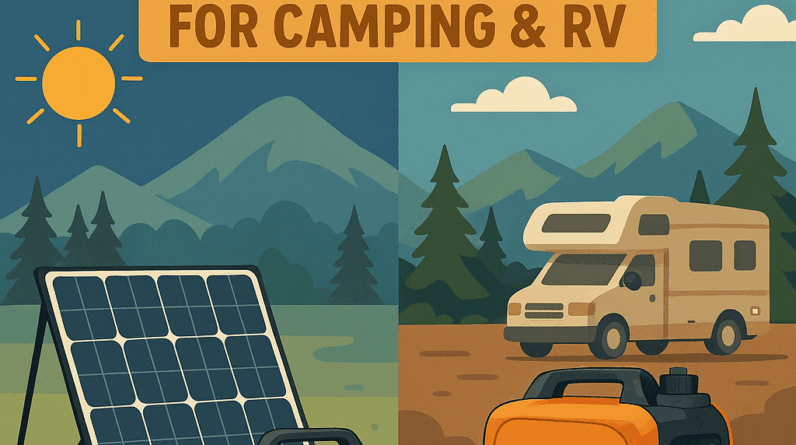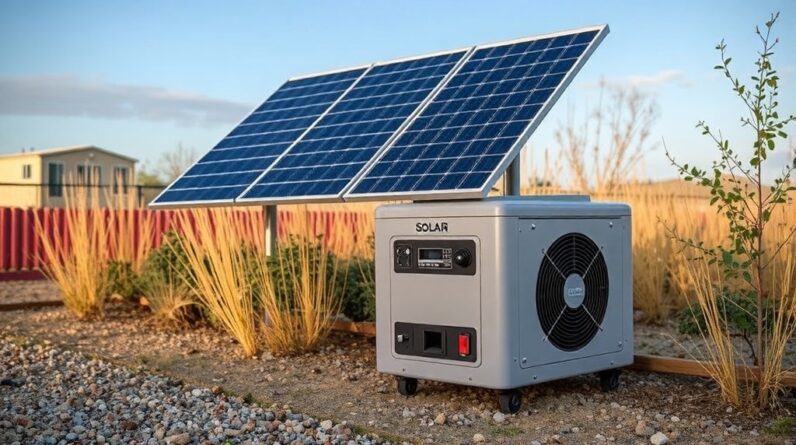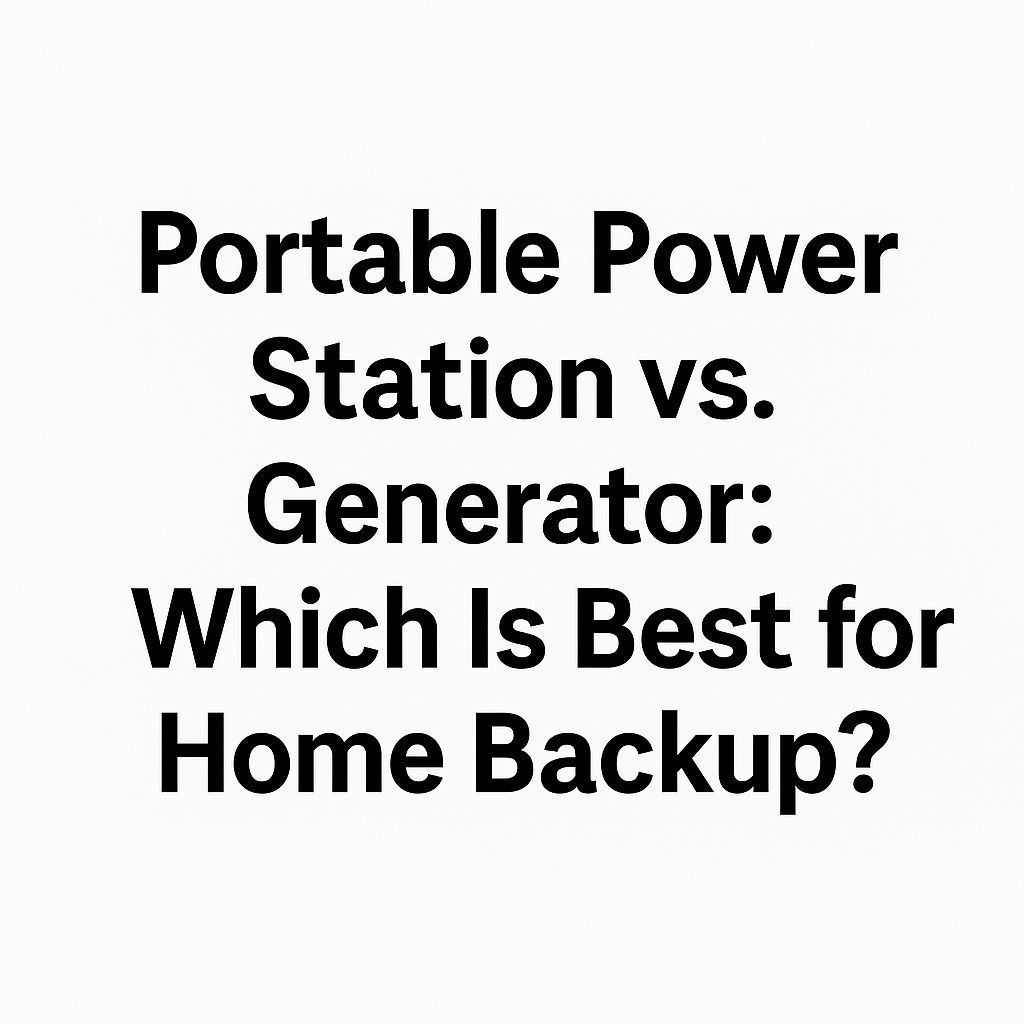
This post contains Amazon affiliate links.
Key Takeaways
- Solar power stations operate silently and can be safely used indoors, while inverter generators produce noise and dangerous emissions requiring outdoor-only operation.
- Inverter generators deliver higher instantaneous power (2000W-6000W+) ideal for heavy appliances, whereas solar stations offer 500Wh-3840Wh with expandable battery capacity.
- Solar power stations require minimal maintenance with no moving parts, while generators need regular oil changes, filter replacements, and engine service.
- The choice depends on your camping style: solar for quiet, eco-friendly flexibility or generators for consistent high-power demands in any weather.
When planning your next RV adventure or camping trip, the power source decision shapes everything from where you can camp to how peaceful your experience will be. Both solar power stations and inverter generators offer reliable off-grid electricity, but they serve different camping styles and power needs.
Why Your Power Choice Determines Your RV Adventure Success
The power solution powering your RV directly impacts your camping experience and destination flexibility. Solar power stations unlock quiet, emission-free operation that allows camping in noise-restricted areas and extends your off-grid capabilities without fuel concerns. Inverter generators provide immediate, high-wattage power regardless of weather conditions, making them essential for power-hungry appliances and extended cloudy periods.
Understanding these fundamental differences helps RVers choose the right power strategy for their specific adventure style. Solar Emergency Charger specializes in helping outdoor enthusiasts navigate these power decisions with expert guidance on portable power solutions.
Both technologies serve critical roles in modern RV life, with many experienced campers using hybrid approaches that combine solar charging with generator backup for maximum flexibility and reliability.
Silent vs Loud: The Noise Factor That Changes Everything
Solar Power Stations: Silent Operation for Peaceful Camping
Solar power stations operate in complete silence, producing zero mechanical noise during both charging and power output phases. This whisper-quiet operation preserves the natural ambiance that draws many people to outdoor adventures in the first place. The absence of engine noise allows campers to enjoy bird songs at dawn, maintain conversations without shouting, and respect quiet hours in campgrounds.
The silent operation becomes particularly valuable in noise-sensitive environments like national parks, state campgrounds with strict quiet hours, or when camping near other RVers who value tranquil experiences. Unlike any fuel-powered alternative, solar stations allow power use inside the RV at night without disturbing sleeping family members or neighbors.
Inverter Generators: Significantly Quieter Than Traditional Generators
Modern inverter generators represent a major advancement in noise reduction compared to conventional generators. Quality inverter RV generators operate significantly quieter than traditional portable generators currently available on the market. WEN inverter generators specifically target camping and RVing applications where low noise becomes a priority.
The quieter operation stems from inverter technology that adjusts engine speed to match power demand rather than running at constant high RPM. However, even the quietest inverter generators still produce 50-60 decibels of sound during operation, equivalent to normal conversation levels, which can still impact the natural camping environment.
Power Generation Methods: Fuel vs Battery Storage
How Inverter Generators Create Power From Fuel
Inverter generators burn gasoline or propane through an internal combustion engine to generate electrical power. The generator converts this mechanical energy into alternating current (AC), then uses inverter technology to create clean, stable electricity suitable for sensitive electronics. This fuel-to-power conversion happens instantaneously, providing immediate electrical output as long as fuel supplies last.
The combustion process requires proper ventilation and creates exhaust emissions, limiting these generators to outdoor-only operation. Fuel consumption rates vary based on power output demand, with most inverter generators consuming 0.3-0.6 gallons per hour at 25% load capacity.
How Solar Power Stations Store Energy for Later Use
Solar power stations function as large battery banks that store electrical energy from external charging sources. These lithium-ion battery systems hold power for extended periods, releasing stored energy through multiple output ports when needed. The EcoFlow River 2 Max weighs approximately 13.4 pounds while providing 512Wh battery capacity, demonstrating how modern battery technology maximizes energy density.
Storage capacity ranges from compact 500Wh units suitable for basic device charging to massive systems like the Anker Solix F3800 with 3840Wh capacity. Higher-capacity models can expand power supply up to 26.9kWh with additional battery packs, creating home-backup-level energy storage.
Recharging Options: Solar Panels, Wall Outlets, and Car Adapters
Solar power stations offer multiple recharging methods that provide flexibility for different camping scenarios. Solar panel charging harnesses renewable energy during daylight hours, with charging times varying based on panel wattage and sunlight conditions. Wall outlet charging provides fastest recharge times, with some models like the EcoFlow River 2 Max reaching 100% capacity in just one hour using AC power.
Car adapter charging utilizes the vehicle’s 12V system during travel, allowing power station recharging while driving between destinations. This charging versatility ensures power availability regardless of weather conditions or campground electrical hookups, making solar stations highly adaptable to changing circumstances.
Indoor Safety: Where You Can Actually Use Your Power Source
Solar Power Stations: Safe for Indoor and Outdoor Use
Solar power stations produce zero emissions, making them completely safe for indoor operation within RVs, tents, or enclosed spaces. The battery-powered design eliminates carbon monoxide risks, toxic fume concerns, or ventilation requirements that plague fuel-powered alternatives. This safety advantage allows nighttime power use for medical devices, electronics charging, or emergency lighting without health risks.
The absence of combustion also eliminates fire hazards associated with fuel storage and handling. Solar stations can operate safely in small spaces, making them ideal for apartment dwellers, van lifers, or anyone requiring indoor backup power during emergencies.
Inverter Generators: Outdoor-Only Due to Dangerous Emissions
Inverter generators must never operate indoors due to deadly carbon monoxide emissions from their combustion engines. The Consumer Product Safety Commission (CPSC) warns of the risk of carbon monoxide poisoning, advising that generators should be used outside, far away from windows, doors, and vents.
The outdoor-only limitation restricts generator use during severe weather conditions and creates security concerns when left unattended outside overnight. Additionally, fuel storage requirements add complexity and safety considerations for RV storage and travel.
Real-World Power Performance for RV Appliances
High-Wattage Capability: Generator Models Range from 2000W to 6000W+
Inverter generators excel at delivering high instantaneous power output, with models ranging from 2000W entry-level units to 6000W+ heavy-duty systems. This high wattage capacity makes generators superior for powering energy-intensive RV appliances like air conditioners, electric water heaters, or multiple high-draw devices simultaneously. The Anker SOLIX F3800 Portable Power Station offers 6000W power output capability, demonstrating how advanced solar stations now compete with generator wattage levels.
Generator power output remains consistent regardless of battery charge levels, unlike solar stations that may experience power reduction as battery capacity depletes. This consistent high-power delivery makes generators ideal for applications requiring sustained heavy electrical loads over extended periods.
Battery Capacity: Solar Stations from 500Wh to 3840Wh with Expansion Options
Solar power station battery capacity determines how long devices can operate before requiring recharge. Entry-level 500Wh units power small electronics and LED lighting for several hours, while mid-range 1000-2000Wh systems handle refrigerators, fans, and device charging for 1-2 days. High-capacity models like the Anker Solix F3800 with 3840Wh capacity can power entire RV electrical systems for extended periods.
Expandable battery systems allow users to scale power storage based on specific needs and budget. Multiple battery units can link together, creating massive energy reserves suitable for extended off-grid living or emergency backup power lasting days or weeks without recharging.
Runtime Comparison: Fuel Efficiency vs Solar Charging
Inverter generators adjust their engine speed to match power demand, achieving superior fuel efficiency compared to traditional generators. Fuel consumption rates and runtime vary by specific model and load conditions, with fuel availability becoming the limiting factor for extended operation periods.
Solar stations provide runtime based on battery capacity and power consumption rates. A 1000Wh solar station running a 100W load operates for approximately 10 hours, but recharge time varies significantly based on charging method and weather conditions. Solar charging may require 6-8 hours of direct sunlight, while AC wall charging typically completes within 2-4 hours.
Environmental Impact and Maintenance Requirements
Zero Emissions vs Fuel Consumption
Solar power stations produce zero emissions during operation, making them environmentally friendly power solutions that don’t contribute to air pollution or greenhouse gas production. The renewable energy charging capability, particularly through solar panels, creates a completely sustainable power cycle that reduces dependence on fossil fuels. This eco-friendly operation aligns with Leave No Trace camping principles and environmental conservation values.
Inverter generators burn fossil fuels, producing carbon monoxide, nitrogen oxides, and other combustion byproducts that impact air quality and contribute to environmental degradation. Fuel consumption also requires ongoing petroleum product purchases, creating both environmental costs and recurring expenses throughout the generator’s operational life.
Low vs High Maintenance: Solar Cleaning vs Engine Service
Solar power stations require minimal maintenance due to their lack of moving parts, which significantly reduces mechanical failure risks and maintenance costs. Basic care involves keeping solar panels clean for optimal charging efficiency and ensuring battery connections remain secure. The absence of filters, oil, spark plugs, or mechanical components eliminates most traditional maintenance requirements.
Inverter generators demand regular engine maintenance including oil changes, air filter cleaning or replacement, and spark plug inspection. Refer to the manufacturer’s guidelines for specific maintenance intervals. Seasonal maintenance may include fuel stabilizer addition, carburetor cleaning, and storage preparation. These maintenance requirements add ongoing costs and complexity to generator ownership.
Choose Solar for Quiet Flexibility or Generators for High Power Demands
The decision between solar power stations and inverter generators ultimately depends on individual camping styles, power requirements, and environmental priorities. Solar power stations excel for campers who value quiet operation, indoor safety, environmental sustainability, and low maintenance requirements. They work best for moderate power needs, extended off-grid stays, and situations where noise restrictions apply.
Inverter generators serve RVers with high power demands, needs for consistent electricity regardless of weather conditions, and applications requiring immediate high-wattage output. They remain essential for powering air conditioning, electric heaters, or multiple high-draw appliances simultaneously. Many experienced RVers adopt hybrid approaches, using solar for daily power needs while maintaining generator backup for heavy loads or extended cloudy periods.
Consider solar power stations for quiet campground compliance, overnight indoor operation, and environmentally conscious camping. Choose inverter generators when consistent high power trumps noise concerns and when fuel availability isn’t a limiting factor. The optimal solution often involves understanding both technologies’ strengths and incorporating them strategically based on specific trip requirements and camping destinations.
For expert guidance on selecting the right portable power solution for your outdoor adventures, visit Solar Emergency Charger to explore power options and professional recommendations.
This post contains Amazon affiliate links.






